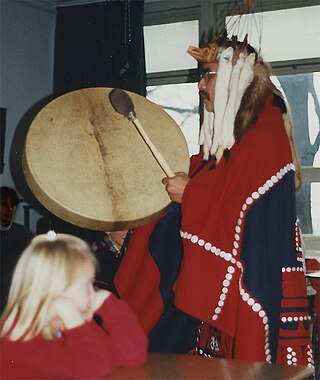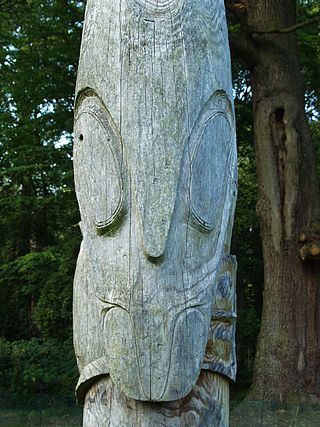David Robert Boxley (born July 27, 1981), also known as D. Robert Boxley, is an Alaskan Tsimshian artist and totem-pole carver from the Tsimshian community of Metlakatla, Alaska. He is the son of the carver David A. Boxley, his mentor. His mother, Elizabeth, is non-Native, but was adopted into the Tsimshian Laxsgiik (Eagle clan).
His former Tsimshian name was Lapaaygm xsgyiik, which means "He Who Flies Like the Eagle" in the Tsimshian language.
In 1999 he, along with his brother, Zach, was adopted into the Laxgyibuu (Wolf Clan), House of T'ałm Ha'ax, by Doreen Nathan, his father's aunt. This was done to correct his Eagle clan affiliation since he had to have an opposite clan from his father, David A. Boxley. (Tsimshian Indians follow the matrilineal tradition of most Northwest Coast tribes.)
He was given the name Gyibaawm laxha, which means "Wolf of the Sky". This was to honor his new clan, but also to pay homage to his former clan, the Laxsgyiik (Eagle clan).
By the 1980s he was living with his parents and brother Zachary in Kingston, Washington.
Since 2000, he has carved twenty five totem poles with his father and on his own. His first solo totem pole was made in 2005.

Totem poles are monumental carvings found in western Canada and the northwestern United States. They are a type of Northwest Coast art, consisting of poles, posts or pillars, carved with symbols or figures. They are usually made from large trees, mostly western red cedar, by First Nations and Indigenous peoples of the Pacific Northwest Coast including northern Northwest Coast Haida, Tlingit, and Tsimshian communities in Southeast Alaska and British Columbia, Kwakwaka'wakw and Nuu-chah-nulth communities in southern British Columbia, and the Coast Salish communities in Washington and British Columbia.

The Tsimshian are an Indigenous people of the Pacific Northwest Coast of North America. Their communities are mostly in coastal British Columbia in Terrace and Prince Rupert, and Metlakatla, Alaska on Annette Island, the only reservation in Alaska.
The Tlingit clans of Southeast Alaska, in the United States, are one of the indigenous cultures within Alaska. The Tlingit people also live in the Northwest Interior of British Columbia, Canada, and in the southern Yukon Territory. There are two main Tlingit lineages or moieties within Alaska, which are subdivided into a number of clans and houses.
Roy Henry Vickers, is a Grammy Award nominated Canadian First Nations artist. He owns and operates a gallery in Tofino, British Columbia.

Gitxsan are an Indigenous people in Canada whose home territory comprises most of the area known as the Skeena Country in English. Gitksan territory encompasses approximately 35,000 km2 (14,000 sq mi) of land, from the basin of the upper Skeena River from about Legate Creek to the Skeena's headwaters and its surrounding tributaries. Part of the Tsimshianic language group, their culture is considered to be part of the civilization of the Indigenous peoples of the Pacific Northwest Coast, although their territory lies in the Interior rather than on the Coast. They were at one time also known as the Interior Tsimshian, a term which also included the Nisga'a, the Gitxsan's neighbours to the north. Their neighbours to the west are the Tsimshian while to the east the Wetʼsuwetʼen, an Athapaskan people, with whom they have a long and deep relationship and shared political and cultural community.
The Gitga'at are one of the 14 tribes of the Tsimshian nation in British Columbia, Canada, and inhabit the village of Hartley Bay, British Columbia, the name of which in the Tsimshian language is Txałgiu. The name Gitga'ata in the Tsimshian language means "people of the cane". The Gitga'ata, along with the Kitasoo Tsimshians at Klemtu, B.C., are often classed as "Southern Tsimshian," their traditional language being the southern dialect of the Tsimshian language. Most Tsimshian-speakers in Hartley Bay today, however, speak the form of the language shared by villages to the north. Their band government is the Hartley Bay Indian Band, aka the Gitga'at First Nation.
Kitsumkalum is an original tribe/ galts'ap (community) of the Tsimshian Nation. Kitsumkalum is one of the 14 tribes of the Tsimshian nation in British Columbia, Canada. Kitsumkalum and is also the name of one of their Indian Reserve just west of the city of Terrace, British Columbia, where the Kitsumkalum River flows into the Skeena River. Archaeological evidence places Kitsumkalum with property holdings (laxyuup/territories) in the Kitsumkalum Valley, down the Skeena River to the coast, the Zymagotitz River, areas around Lakelse Lake and many special sites surrounding coastal and inland areas of the North West Coast prior to 1846 and as far back as 5,000 years BP.
Kitselas, Kitsalas or Gits'ilaasü are one of the 14 tribes of the Tsimshian nation of British Columbia, in northwestern Canada. The original name Gits'ilaasü means "people of the canyon." The tribe is situated at Kitselas, British Columbia, at the upper end of Kitselas Canyon, which is on the Skeena River. It was once a great trading nexus, just outside and upriver from the city of Terrace. It is the most upriver of the 14 tribes and it borders the territory of the Gitxsan nation.
The Giluts'aaẅ are one of the 14 tribes of the Tsimshian nation in British Columbia, Canada, and one of the nine of those tribes making up the "Nine Tribes" of the lower Skeena River resident at Lax Kw'alaams, B.C. The name Giluts'aaw means literally "people of the inside". Their traditional territory is the area around Lakelse Lake, near present-day Terrace, B.C., at the Skeena River.
The Ginadoiks are one of the 14 tribes of the Tsimshian nation in British Columbia, Canada, and one of the nine of those tribes making up the "Nine Tribes" of the lower Skeena River resident at Lax Kw'alaams, B.C. The name Ginadoiks means literally "people of the rapids". Their traditional territory is the watershed of the Gitnadoiks River, a tributary of the Skeena. Since 1834, they have been based at Lax Kw'alaams, when a Hudson's Bay Company fort was established there.
The Ginaxangiik are one of the 14 tribes of the Tsimshian nation in British Columbia, Canada, and one of the nine of those tribes making up the "Nine Tribes" of the lower Skeena River resident at Lax Kw'alaams, B.C. The name Ginaxangiik means literally "people of the hemlock." Their traditional territory includes the watershed of the Exchamsiks River, a tributary of the Skeena River. Since 1834, they have been based at Lax Kw'alaams, when a Hudson's Bay Company fort was established there.
The Gispaxlo'ots are one of the 14 tribes of the Tsimshian nation in British Columbia, Canada, and one of the nine of those tribes making up the "Nine Tribes" of the lower Skeena River resident at Lax Kw'alaams, B.C. The name Gispaxlo'ots means literally "people of the place of elderberries." Their traditional territory includes an area on the Skeena River between present-day Terrace and Prince Rupert. Since 1834, when a Hudson's Bay Company trading fort was established at Lax Kw'alaams, they have been based there. Their chief Ligeex permitted the HBC to build on Gispaxlo'ots territory.
The Gitando are the youngest of the 14 tribes of the Tsimshian people in British Columbia, Canada. It is one of the nine of those tribes making up the "Nine Tribes" First Nation of the lower Skeena River resident at Lax Kw'alaams, British Columbia. The name Gitando means the people of weirs. Their traditional territory includes the watershed of the Exstew River, a tributary of the Skeena River. Since 1834, the Gitando have been based at Lax Kw'alaams, following establishment of a Hudson's Bay Company trading fort there. They are closely related to the Gispaxlo'ots, another of the Nine Tribes, who have an adjacent territory.
The Gitwilgyoots are one of the 14 tribes of the Tsimshian nation in British Columbia, Canada, and one of the nine of those tribes making up the "Nine Tribes" of the lower Skeena River resident at Lax Kw'alaams, B.C. The name Gitwilgyoots means literally "people of the place of kelp." Their traditional territory includes several areas around the estuary of the Skeena River. Since 1834, they have been based at Lax Kw'alaams, when a Hudson's Bay Company fort was established there.
The Laxgibuu or Laxgyibuu is the name for the Wolf "clan" (phratry) in the language of the Tsimshian nation of British Columbia, Canada, and southeast Alaska. It is considered analogous or identical to identically named clans among the neighboring Gitksan and Nisga'a nations.
Viola E. Garfield was an American anthropologist best known for her work on the social organization and plastic arts of the Tsimshian nation in British Columbia and Alaska.
Ligeex is a hereditary name-title belonging to the Gispaxlo'ots tribe of the Tsimshian First Nation from the village of Lax Kw'alaams, British Columbia, Canada. The name, and the chieftainship it represents, is passed along matrilineally within the royal house called the House of Ligeex. The House of Ligeex belongs to the Laxsgiik.

David A. Boxley is an American artist from the Tsimshian tribe in Alaska, most known for his prolific creation of Totem Poles and other Tsimshian artworks.

Norman Tait was a Nisga'a First Nations sculptor and totem pole carver from northwestern British Columbia, Canada.

The culture of the Tlingit, an Indigenous people from Alaska, British Columbia, and the Yukon, is multifaceted, a characteristic of Northwest Coast peoples with access to easily exploited rich resources. In Tlingit culture a heavy emphasis is placed upon family and kinship, and on a rich tradition of oratory. Wealth and economic power are important indicators of status, but so is generosity and proper behavior, all signs of "good breeding" and ties to aristocracy. Art and spirituality are incorporated in nearly all areas of Tlingit culture, with even everyday objects such as spoons and storage boxes decorated and imbued with spiritual power and historical associations.